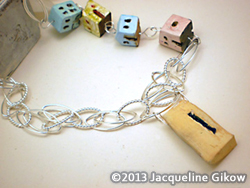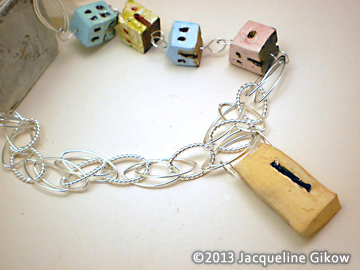Polymer Clay House Necklace
by Jacqueline Gikow

Instructions for making a polymer clay house necklace are provided below.
Conditioning the Clay
Before you can make anything from polymer clay, you need to condition it. To make the clay workable, the plasticizer molecules in the clay have to be in alignment. The time it takes to condition the clay differs from brand to brand. A good way to tell if the clay is fully conditioned is when the color is uniform throughout the piece of clay.
Using a pasta machine is the best way to condition the clay. What you do is to flatten one end, straight from the package and run it through the thickest setting. Fold the clay in half lengthwise, then run it through again by inserting it into the pasta machine fold first to squeeze out the air bubbles. Repeat this action 15 to 20 times for the best result.
You can also condition the clay by hand. Start by rolling the block of clay into a ball, and then roll it into a snake on a clean surface. Fold the snake in half and reshape it into a ball, then once again into a snake shape. Repeat this until the clay is soft and pliable, but has some stretch when you pull it.
Cutting and Slicing
Long blades are the best for slicing your clay. Flexible, rigid, and rippled blades are available at an art & craft store or online. These blades are very sharp and should be handled with extreme care. Wallpaper blades, mat-cutting blades, and X-Acto blades can also be used. If you are working with children, good alternatives are plastic scrapers found in kitchen departments, or even plastic credit cards. Plastic knives can be sharp, so use them with care.
Baking
Baking temperatures and times vary among manufacturers and sometimes even between colors of the same brand, usually from 265 degrees to 275 degrees. Lighter colors can require shorter baking times so read the package instructions carefully. For baking the objects made in clay, toaster and convection ovens work quite well, but the settings aren’t always exact, so invest in an oven thermometer. For smaller items such as jewelry and beads, use ceramic tile as a good baking surface.
Baking Beads
Beads can be pierced before baking or drilled after baking. You can bake unpierced beads on cardboard that has been folded into an accordion rack. If you pierce the beads before baking, string them on wire and use a polymer clay lump or cardboard to hold the wire off the baking surface.
Materials and Tools For Making a Polymer Clay Necklace
24 inches (60.9cm) Silver-plated open link hammered chain
1-ounce (28g) white polymer clay
Acrylic paint in an assortment of colors
White acrylic paint
Burnt umber acrylic paint
22 gauge dead soft silver wire (approx 24 inches)
4 open silver jump rings (10mm)
Silver toggle clasp
Tissue-slicing blade
X-Acto knife
Chain-nosed pliers
Round-nosed pliers
Flush cutters

Instructions For Making a Polymer Clay Necklace
1. Condition the polymer clay.
2. Create four houses from white polymer clay. Follow the shapes on the picture shown above. The average size of the houses is 1/2 inch (13mm) square. Notice that the houses are slightly different shapes. Use the tissue-slicing blade to rough cut the houses and the X-Acto blade to fine-tune the shapes. Insert a hole through the bottom to the top of each house.
3. Form a door-shaped pendant. This bead should be about 1 1/4 inches (3mm) long, 3/4 inches (19mm) wide, and 1/2 inch (13mm) deep. Create a hole in the pendant from at the top from side to side. Dig a shallow hole in the pendant.
4. Bake the polymer clay beads following the manufacturer’s instructions. Let them cool.
5. Mix the colored acrylic paint with white acrylic paint to make pastel colors. Paint each house a different pastel color. Use a fine brush to fill the house windows and doors with burnt umber acrylic paint.
6. Mix the burnt umber and white acrylic paint to match the door illustrated in the photograph above. Use a fine brush to fill the shallow hole with burnt umber paint.
7. Insert 3 inches (8cm) of 22 gauge silver wire into each of the four houses so that half of the wire remains at each end. Hold the wire flat to the top of the bead with round nose pliers. Bend the wire at a 90-degree angle. Wrap the wire around the jaw of the round nose pliers, making a loop. Grasp the wire with a pair of chain nose pliers and wrap it tightly, working from the bottom of the loop to the top of the house bead. Cut off the wire tail with flush cutters.
8. Repeat step 7 at the bottom of each house bead. However, before wrapping the wire around the loop, insert the wire into the loop you made at the top of the bead.
9. Insert 6 inches of wire through the door pendant hole. Follow directions 7 and 8, but insert each loop into a chain loop so that it hangs down.
10. Insert a jump ring into each end of the chain. Then open one jump ring and slide the large portion of the toggle clasp in and close the jump ring. Repeat this approach with the straight bar of the toggle clasp.
Related articles
Polymer Clay Basics | Make Faux Ivory Buttons | Clay Basics | Precious Metal Clay
